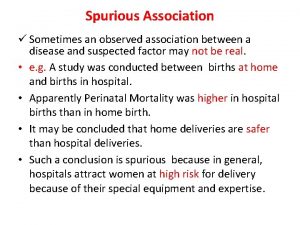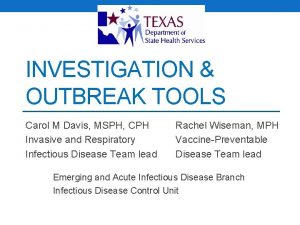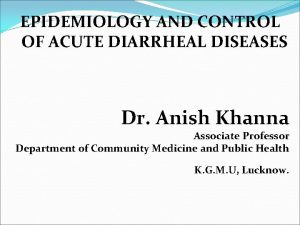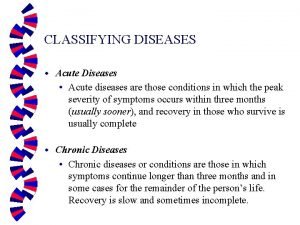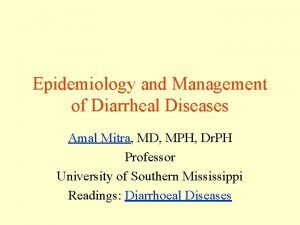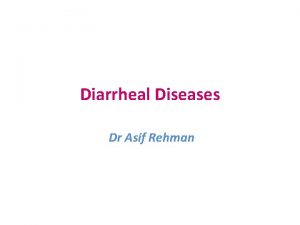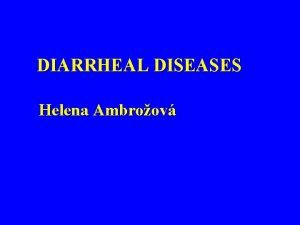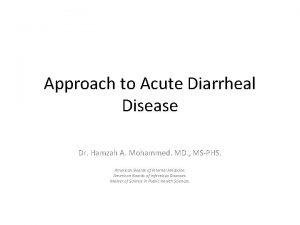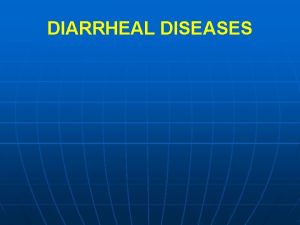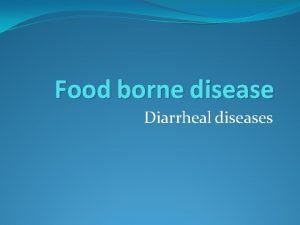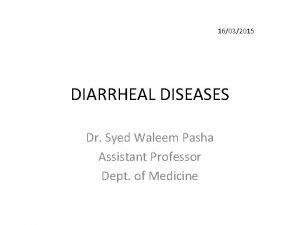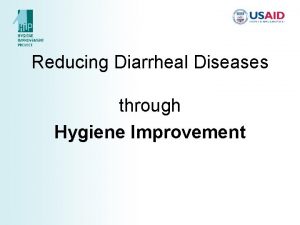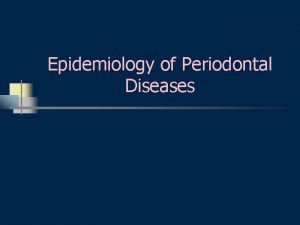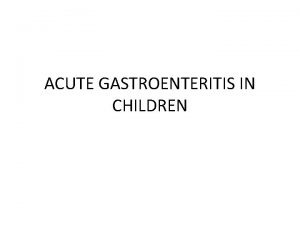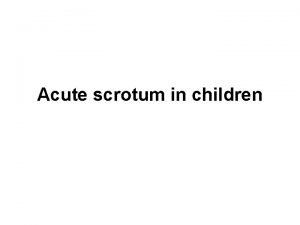EPIDEMIOLOGY AND CONTROL OF ACUTE DIARRHEAL DISEASES Dr






















- Slides: 22

EPIDEMIOLOGY AND CONTROL OF ACUTE DIARRHEAL DISEASES Dr. Anish Khanna Associate Professor Department of Community Medicine and Public Health K. G. M. U, Lucknow.

WHAT IS DIARRHOEA? Ø Diarrhoea is the passage of loose, liquid or watery stool. ØIn many regions Diarrhoea is defined as passage of three or more loose or watery stools in 24 hour period. ØHowever it is the recent change in consistency and character of stool than the number of stools that is more important. ØIn most cases the mother knows what is abnormal stool for her child. ØIt is a killer disease in children. ØOne in four deaths in children under the age of 5 yrs. is due to diarrhoea.

WHAT CAUSES DIARRHOEA? Infectious Disease Agents Causing Diarrhoea. 1. BACTERIA Escherichia coli It produces heat labile (LT) and heat stable (ST) entertoxins. E. COLI - COULD BE Ø Enteropathogenic- Causes infantile diarrhoea. Entero toxigenic – Causes travellers diarrhoea. Enteroinvasive- Dysentery type of diarrhoea. Enteroadherent Enterohaemorrhagic VIBRIO CHOLERAE- produces enterotoxins Vibrio para haemolyticus- Invasive. Ø Non-Cholerae vibrios Ø Ø Ø

WHAT CAUSES DIARRHOEA? Infectious Disease Agents SHIGELLAE–Invasive, produce bloody diarrhoea or Dysentery. Ø CAMPYLOBACTER JEJUNI – invasive. Ø SALMONELLAE OTHER THAN S. TYPHI- invasive. Ø STAPHYLOCOCCUS AUREUS- entrotoxins Ø CLOSTRIDIUM PERFRINGENS- enterotoxins. 3. VIRUSES Ø Rotavirus – invasive. 4. PARASITES Ø E. histolytica- invasive. Ø Giardia Lamblia- non invasive.

WHAT IS THE MAGNITUDE OF THE PROBLEM? WORLD WIDE? IN INDIA? Ø NFHS- 2 data highlights morbidity profile of under 3 yrs. Fever- (27%) A. R. I. - (17%) Diarrhoea – (13%) Under Wt. (43%) Ø Often due to a combination of these conditions. Ø Diarrhoeal diseases are a major public health problem among children under 5 yrs. of age. Around 8 -11 million cases are being reported annually in India. Ø

WHAT IS THE EPIDEMIOLOGY OF DAIRRHOEAL DISEASES? Ø RISK FACTORS OR DETERMINANTS Ø AGENT FACTORS Ø HOST FACTORS Ø ENVIRONMENTAL FACTORS Ø RESERVOIR OF INFECTION.

HOW MANY TYPES OF DIARRHOEA ARE THERE? Ø ACUTE WATERY DIARRHOEA. Ø DYSENTRY (BLOOD IN STOOLS). Ø PERSISTENT DIARRHOEA.

HOW SHOULD ACUTE WATERY DIARRHOEA IN CHILDREN BE MANAGED? ASSESSMENT OF DEHYDRATION DOES THE CHILD HAVE SIGNS OF DEHYDRATION? IS DEHYDRATION MILD OR SEVERE?

ASSESSMENT OF THE CHILD WITH DIARRHEA FOR THE DEGREE OF DEHYDRATION AND MANAGEMENT Degree of dehydration signs a. Look for General condition Eyes Tears on cry Mouth and tongue Thirst b. Feel for Skin pinch c. Decide d. Treatment Fluid deficit is Mild Severe Restless, irritable Sunken Absent Dry Thirsty (drinks eagerly) Lethargic, floppy, unconscious, Deeply sunken and dry Absent Very dry Very thirsty but (drinks poorly or unable to drink) Goes back slowly, takes 1 to 2 seconds there is some dehydration. Plan B With WHO recommended ORS solution to correct some dehydration. 5 -10% of body weight Goes back very slowly, takes more than 2 seconds There is severe dehydration. Plan C With IV infusion urgently to correct severe dehydration and to prevent death > 10% of body weight

AFTER CLINICAL ASSESSMENT WHAT SHOULD BE DONE? Ø LABORATORY INVESTIGATIONS Ø FEEDING DURING DIARRHOEA Ø RATIONAL USE OF DRUGS # What is the role of anti Diarrhoeals? Ø FLUID THERAPY

FLUID THERAPY IN DIARRHOEA Ø WHAT IS THE PURPOSE OF FLUID THERAPY. Ø APPROPRIATE FLUID THERAPY - ORS Basis of ORS What is the mechanism of action of ORS? Ø OTHER FLUIDS HAF -SSS (Sugar salt solution)

WHAT SHOULD BE THE TREATMENT OF CASES OF ACUTE WATERY DIARRHOEA Ø THREE CATEGORIES OF CASES. Ø Cases with No Signs of dehydration- Plan-A. Ø Cases with some signs of dehydration- Plan-B Ø Cases with severe dehydration-Plan -C

HOW CAN DIARRHOEA BE PREVENTED? PREVENTIVE STRATEGIES. Ø Sanitation - Hand washing - Exclusive breast feeding - Clean food Ø Environmental sanitation Ø Elimination of Reservoirs Ø Breaking the channel of transmissions

PREVENTION OF DIARRHOEA? ELIMINATION OF RESERVOIRS Ø Prevention of dehydration Ø Correction of dehydration Ø Maintenance of hydration Ø Chemotherapy Ø Restoration of Nutritional Status. Ø Diarrhoea- Leads to malnutrition Ø Increase in Breast feeding frequency Ø Increase in diet.

OTHER PREVENTIVE STRATEGIES? Vitamin –A prophylaxis Ø Improved Nutrition Ø Immunization - Measles immunization ROTA VIRUS VACCINE Ø Two live oral attenuated rotavirus vaccines were licensed in 2006. Now there are three. Ø Monovalent human rotavirus vaccine (Rotarix). Ø The pentavalent bovine- Human reassortant vaccine (Rota Teq) Ø They Provide 75 -80% protection against rotavirus diarrhoea and 90 -100% protection against rotavirus disease. Ø

WHAT ARE THE NATIONAL PROGRAMS FOR DIARRHOEA IN INDIA National diarrhoeal disease control program (NDDCP) Ø Diarrhoeal disease control program started in 1978. Ø 1985 – 86 National Oral Rehydration Therapy Program Ø Case management of diarrhoea by HAF & ORS. Ø Improvement of maternal knowledge with egard to HAF and practices

Ø Since CSSM Program became a part of RCH program in 1997, Integrated Management of Child hood Illness (IMCI) has been adopted in India. Ø IMCI deals with all children not only sick children - Diarrhoea - Pneumonia - Measles - Malaria - Health promotion - Immunization - Breast feeding - Vit. A & Iron Supplementation

Ø WHAT ARE THE REVISED GUIDELINES FOR MANAGEMENT OF DIARRHOEA? GOI & IAP (Indian Academy of Pediatrics) Ø Low osmolarity ORS Ø Zinc (10 mg Elemental Zinc for infants 2 -6 month of age 20 mg Zinc for children > 6 months for 14 days) Ø Feeding of energy dense foods in addition to Breast feeding Ø HAF Ø Hygiene Ø Antimicrobials for gross blood in stools or shigella + culture.

MCQ’s in Diarrhoea 1. WHO ORS contains: A) Sodium Chloride 2. 5 gm B) Potassium Chloride 1. 5 gm C) Glucose 20 gm D) Sucrose 10 gm E) Potassium Bicarbonate 2. 5 gm Ans- B, C, E 2. For controlling an outbreak of Cholera all of the following measures are recommended except: A) Mass chemoprophylaxis B) Proper disposal of excreta C) Chlorination of water D) Early detection and management of cases Ans- A

3. In ORS the concentration of sodium chloride is: A) 3. 5 gm B) 2. 5 gm C) 2. 9 gm D) 1. 5 gm Ans- A 4. Drug of choice for carriers of typhoid is: A) Ampicillin B) Chloramphenicol C) Co-Trimoxazole D) Clindamycin Ans- A

5. Typhoid oral vaccine is given: A) 1, 3, 5 days B) 1, 2, 3 days C) 1, 2, 4 days D) 1, 7, 14 days Ans- A 6. In WHO-ORS concentration of Sodium is: A) 60 m. Eq/l B) 50 m. Eq/l C) 40 m. Eq/l D) 90 m. Eq/l Ans- D

7. True about citrate in ORS: A) Nutritious B) Cheaper C) Increases shelf life D) Tastier Ans- C 8. A convalescent case of Cholera remains infective for: A) less than 7 days B) 7 to 14 days C) 14 to 21 days D) 21 to 28 days Ans- C
 Anti diarrheal drugs list
Anti diarrheal drugs list Certification board of infection control and epidemiology
Certification board of infection control and epidemiology Thesourceagents
Thesourceagents Nutrition epidemiology definition
Nutrition epidemiology definition Difference between descriptive and analytical epidemiology
Difference between descriptive and analytical epidemiology Descriptive vs analytic epidemiology examples
Descriptive vs analytic epidemiology examples Epidemiology person place time
Epidemiology person place time Ukuran asosiasi
Ukuran asosiasi Logistic regression epidemiology
Logistic regression epidemiology Incidence vs incidence rate
Incidence vs incidence rate Ecological study design
Ecological study design Attack rate epidemiology formula
Attack rate epidemiology formula Pros and cons of cross sectional study
Pros and cons of cross sectional study Causal vs association
Causal vs association Attack rate calculation
Attack rate calculation Ramboman acronym
Ramboman acronym Model of disease causation
Model of disease causation Proportion defination
Proportion defination Defination of epidemiology
Defination of epidemiology Cholera 1817
Cholera 1817 What is descriptive study in epidemiology
What is descriptive study in epidemiology Spurious association
Spurious association Field epidemiology ppt
Field epidemiology ppt





















